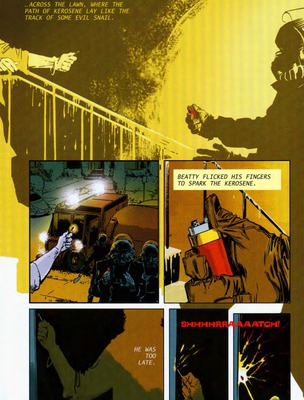Introduction
The graphic novel „Fahrenheit 451“, written by Tim Hamilton in 2009, is based on a novel by Ray Bradbury published in 1953.
It´s about firemen in a dystopian future of America. They are not there to fight the flames – they set fires. They burn books every day because you are not allowed to read. The main character, Guy Montag, is part of the fire brigade. He has to burn and kill daily as well. Ray Bradbury tells us about Guy´s life and everything he does. Later in the story he sees a woman killing herself, which stirs really strong feelings in him.

Bildzitat: Tim Hamilton, Ray Bradbury's Fahrenheit 451, p. 39.
Analysis of Page 39 of the Graphic Novel
Summary
The firemen are about to burn the house of an old lady, but she wants to die when her books are getting burnt. Beatty, the boss of the fire brigade, just wants to spark the kerosene with a lighter when the woman takes a match and kills herself with all the books she owned.
Context
Shortly before the firemen had been informed about the books and drove to the woman´s house. But she does not want to leave the house when the firemen spill kerosene everywhere. After she died Montag is no longer able to sleep. He talks to his wife, but she does not want to talk about anything else then the programme of the parlour walls. Guy seems to be sick the next morning, but is he?
Analysis
The excerpt basicly shows three main colours: red, yellow and brown. The only red things are Beatty's lighter and the old lady's match. Red is a colour of fire and danger and the lighter is there to foreshadow that the kerosene will be set on fire. Yellow is a colour of fire as well. In this case it stands for the kerosene which is compared to the slime of an evil snail. The entire background is brown and black. This could remind us of the night or the cruelty of the situation. It seems very dark and scary.
The characters in this excerpt are Montag, Beatty, the other firemen and an old woman. The firemen are completely black with some blue accents. You cannot really see their facial expressions and mimics. You are also just able to see their arms and hands moving. The woman is just a shadow. She is also just moving arms and hands. You can say the firemen, who all wear their uniforms, are no individuals. They generally representr "the bad guys".
The firemen and the old lady are all standing upright, which could stand for their strength and the fact that none of them wants to give up. The old lady may be powerless, but her suicide is an act of rebellion against an unjust system.
Panels one and two are long shots, so you can see what is happening clearly. Panel three is an extreme close-up of Beatty´s lighter. This reveals what Beatty is about to do next and creates a tense atmosphere. The last two panels show how the woman kills herself with a match. These are again close ups, separated by moment-to-moment gutters, which create suspense.
The whole fire brigade is seen from a high angle; the woman from a neutral angle. If you think about this window scene the woman seems to be stronger than the firemen, because it seems that she looks down on them.
The excerpt does not even contain a single balloon. There are captions only, because the firmen and the old lady do not talk to each other. The most important thing therefore is the story and not the text.
There is one onomatopoetic sound on page 39: the sound of the match getting lit. This is very dramatic, because it is the last thing the woman does before committing suicide.
Evaluation
The graphic novelist wants to show us what a wicked act of cruelty it is to burn books and their owners. The main message of the excerpt is that censorship is wrong and that taking away people's freedom to read and think what they want may hurt them so deeply that they do not see a purpose in life if under permament control. It also emphasizes that we should be true to ourselves and fight for what we love.
I think Tim Hamilton conveyed his message very effectively. The choice of colours, shots, gutters and the illustration of the characters make this a very exciting and shocking page to read - with a strong and important message.
by Ole (Year 9)